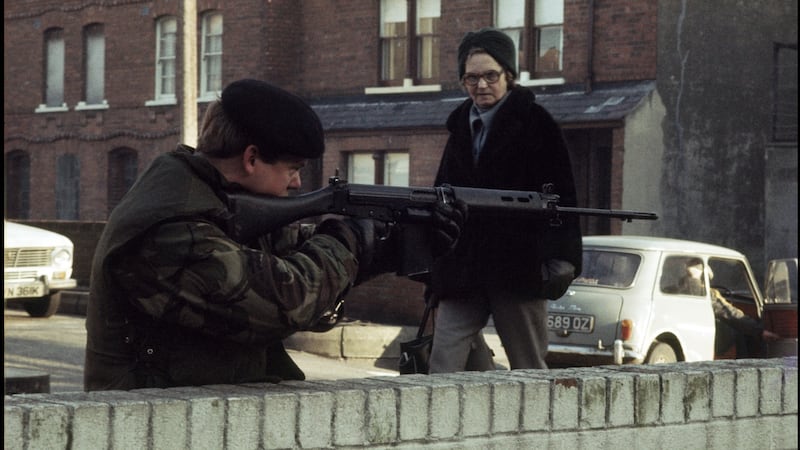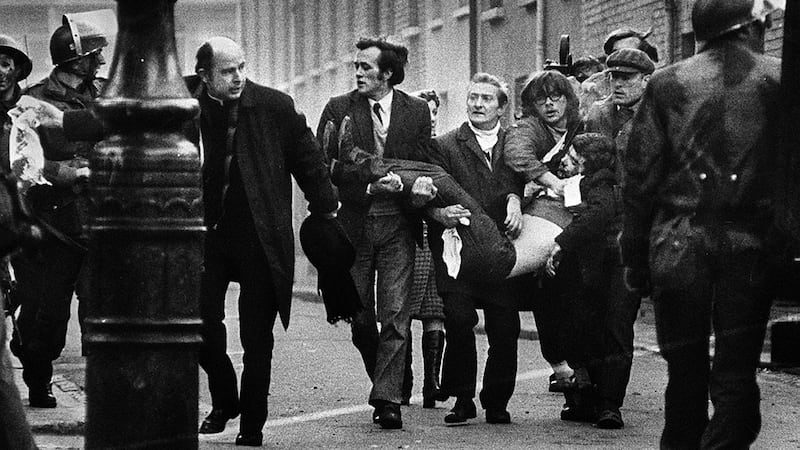Edward Burke’s new book examines the story of British army soldiers who served in Northern Ireland during the Troubles.
On July 30th, 1972, the British army commander in Derry, Brigadier Pat MacLellan, sent a memorandum to all of his units, barely six months after the fatal shooting of 14 unarmed protesters on Bloody Sunday.
It was the eve of Operation Carcan, the ultimately-successful plan to retake parts of IRA-held “no go” areas. MacLellan urged his soldiers to be “selective, restrained and highly disciplined . . . We are their army.”
The idea that British soldiers were “the army” of the Catholic people of the Bogside, Brandywell and the Creggan illustrated the chasm of understanding that existed between Derry Catholics and the soldiers who thought they were operating “at home”.
More than 40 years on, many of those who served with the British army are angry about, or fear the possibility of prosecution for actions taken on the streets and fields in Northern Ireland when they were young men.
Pressed by some right-wing Conservative MPs and the DUP, the British government is considering whether to impose a statute of limitation on the prosecution of soldiers for crimes allegedly committed during service there.
Even the name of the 1972 operation in Derry – Carcan: “an iron ring used for a form of public humiliation of a prisoner by exposition at a pole” – suggested, however, a punitive operation rather than one of liberation.
Casualties in the months before had been high: more British soldiers were killed in Northern Ireland in 1972 than in any year during the 10 years spent by the British Army in Afghanistan.
Bunker mentality
Such losses reinforced a bunker mentality. The soldier’s first loyalty was to his colleagues. Anybody who challenged the group’s security and ascendency, including Ulster loyalists, would be self-evidently hated and often targeted.
“On the streets the [soldiers] didn’t care who the hell you were. You got a rap over the knuckles, followed by a rap over the head if you didn’t push off,” as one former officer declared.

Most soldiers interviewed for An Army of Tribes appear to have had ambivalent, if not positive, attitudes towards Ireland before deploying on Operation Banner – at 38 years, the longest-lasting operation in the British army's history.
Many soldiers had Irish parents or grandparents – up to a third of soldiers in some Scottish regiments were Catholics. Places such as Clydeside in Glasgow were “red” Labour more than Ulster “orange”.
Local newspapers in Scotland and trade unions were often quick to condemn the “fascistic” nature of Ulster loyalism. But attitudes could quickly harden once a unit started taking casualties.
Soldiers began to spread guilt or culpability to cover the inhabitants of whole areas. Anti-Irish rhetoric was more typical than simple sectarian abuse. Soldiers generally did not want to offend their mates.
The hatred was not confined to locals. It extended to the US navy which ran a US naval communications station in Derry until 1977, during some of the worst years of the Troubles.
One out of every three single American sailors who came to Derry married local girls. Many of them sympathised not with their fellow military, but with local nationalists and shared their hatred of the British army.
“These guys treated the [British] army with the sort of hostility that they would show the police in the United States. They tended to view things in black and white,” according to a former US navy yeoman stationed in Derry during 1972.
Fights between the US navy and British soldiers were common. Some sailors were provoked by Bloody Sunday into choosing sides, including one sailor whose wife’s relations lived in the Rossville flats in the Bogside, right at the heart of the shootings.
Shortly afterwards he and another sailor decided they wanted to help the IRA. Brought by a local to a meeting in a house in the Bogside, they were met by IRA men, led by Martin McGuinness.
“McGuinness thanked us for offering to help, said that he appreciated our sympathy, but that the best thing we could do [was] to stay out of it,” he remembered.
Local loyalists were well aware of the US navy/IRA ties. Armed US navy personnel were sent to protect the US navy transmitter base in Dungiven, amid fears that it might be attacked by loyalist paramilitaries. Bomb threats were also made against the naval base during a ceremony in July 1972.
According to a British army intelligence report, a US sailor was a suspected driver for senior IRA volunteers. A former British army officer later recounted how he discovered US sailors moving weapons on behalf of the IRA.
Cut off
Being cut off, hated even, by local women – not just in Derry in the face of better-paid, more exotic American sailors, but elsewhere, too – is a constant theme of soldiers, at the time and when interviewed four decades later.
Gerry Adams draws a direct link between colonial operations and Northern Ireland. According to this view, this was simply another rear-guard, dirty war of the British empire
One ex-Argyll and Sutherland Highlanders’ private recalled how much he had looked forward to visiting the home of the McCumiskey family in south Armagh in 1972. The McCumiskeys were one of the few to offer a friendly word.
The family’s 19-year-old daughter, Nancy, made the mistake of talking to a lance-corporal one afternoon in 1972, shortly before he was shot and seriously wounded by an IRA sniper.
A few days later, arriving for Mass at St Brigid’s Catholic church in Glassdrumman, McCumiskey was dragged from her family’s car and tied to a pole beside the church, where tar and feathers were poured over her.
Such incidents traumatised victims, but they affected soldiers, too. By association they had become unclean or hateful, like “lepers of old”. Insulted, shocked and angry, they sought revenge, they recall now.
The constant verbal abuse took its toll: any perceived weakness such as physical appearance, or a stutter would be exploited. A black soldier was called "Banana Muncher" by the Derry IRA newspaper, Volunteer, and told to "find a tree to hide in".
In turn, some soldiers began to demonise the Catholic poor as inherently “dirty” or savage, emphasising a moral or social distance between themselves and the local inhabitants.
Locals either helped the IRA or stayed silent, soldiers believed. Soldiers’ cartoons showed primitive-looking, drunken Irishmen, lurking with barely-concealed guns and bombs along with captions such as: “An innocent Irish bystander about to do an honest day’s work.”
Struggling to kill
However, in their eyes, according to interviews and battalion records, some British soldiers still struggled to kill, to open fire on an IRA gunman from a concealed position. A former officer involved in sniper training recalled: “I found the problem was to get guys to shake off the view – ‘Am I really right to be doing this between WH Smith and a Marks & Spencers?’ And, meanwhile, seeing granny pushing grandchild down the road in a pram. This makes a big difference.
“All the other places, wherever we had been had been peasant countries where you are in a different country, where natives are natives. Here they are not natives; they are your kith and kin. The topography is exactly as you recognise it at home. Yet you have a rifle in your hands. You are faced with a situation and your first instinct is: ‘This can’t be happening.’ And that takes training and time; it made Ireland such a unique operation.”
Such “inefficiency”, he believed, led to the death of more soldiers because of an inability to shoot IRA volunteers. Embarrassed, soldiers would often claim a hit, convincing themselves that they had shot accurately.
In the eyes of nationalists and republicans, however, such beliefs about restraint are hard to accept. Gerry Adams draws a direct link between colonial operations and Northern Ireland. According to this view, this was simply another rear-guard, dirty war of the British empire.
The army, Adams argued, was irredeemably anti-Irish, sectarian (at least in the case of Scottish soldiers) and colonial in its mindset.
During my research, I came to a somewhat different conclusion.
Rather than being a monolithic, hierarchical institution, lashing out according to a cold, colonial template, the British army was often uncertain, during a time of major change after the shadows had fallen on much of the empire.
Often, behaviour came down to the decisions made by the company commander: “When we took over from the parachute battalion it was too dangerous to drive down the Old Park Road in Belfast; we could only patrol on foot,” recalled Major Martin Smith.
Describing his approach as “tough but fair”, the Grenadier Guards officer remembers: “I never allowed more than four Irishmen to group together. At night I switched off all street lights with the master key so the IRA couldn’t see us.
“But they had a key too, so switched them on to set up ambushes for us. I twice shot out the lights, just as we shot at petrol bombers . . . I was known as the Reverend Bastard,” he declared.

Elsewhere, some officers sought to persuade rather than simply coerce. In Newry in 1972 Major David Thomson of the Argyll and Sutherlands sent his Catholic soldiers to Mass in Newry Cathedral.
Extraordinarily, he went so far as to salute the funeral cortège of an IRA volunteer – though he took the precaution of placing a sniper nearby in case armed IRA volunteers made an appearance.
Watershed moment
The Nancy McCumiskey assault in south Armagh was a watershed moment for the Argylls, its veterans now remember: “It cut us off from the population. No more tea stops, no more regular visits to anybody. We were only putting them and us to danger,” said one.
The different cultures that could exist even within the same regiment is illustrated by the Argylls – the Thomson approach, versus the harder one adopted by the commander of D Company.
In 1982, two Argyll D Company soldiers in Fermanagh were found guilty of stabbing Michael Naan and Andrew Murray to death in a farm near Newtownbutler nearly a decade before, in October 1972.
The killings quickly became known as the “Pitchfork Murders”. Due to the severity of the wounds inflicted on Naan and Murray it was initially assumed locally that a hayfork rather than a knife had been used.
A few hours before the murders, Private “Fluff” Owens, a soldier in 15 Platoon, operating just to the north of the village of Newtownbutler, was declared missing for more than seven hours before eventually turning up, “unharmed but exhausted”.
His temporary disappearance provoked alarm in D Company, which had come to believe – wrongly – that Naan was the IRA quartermaster in Fermanagh, on the back of information from a UDR officer.
Staff sergeant Stanley Hathaway and Sgt John Byrne later received life sentences for murder in Belfast Crown Court in 1981. Former lance-corporal Iain Chestnut was convicted of manslaughter.
Capt Andrew Snowball was found guilty by the same court of withholding information about the killings and the judge gave him a one-year suspended sentence. His military career was effectively over.
Snowball’s death last December aged just 66 went unreported. His neighbours in the Scottish town of Crieff had known him as a kind man, one deeply involved in local community projects. Few, if any, had ever heard of Newtownbutler.
Edward Burke is assistant professor in international relations at the University of Nottingham. An Army of Tribes: British Army Cohesion, Deviancy and Murder in Northern Ireland is published in paperback by Liverpool University Press on February 28th









